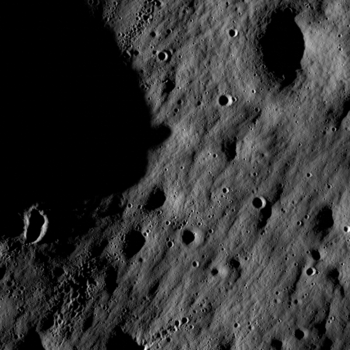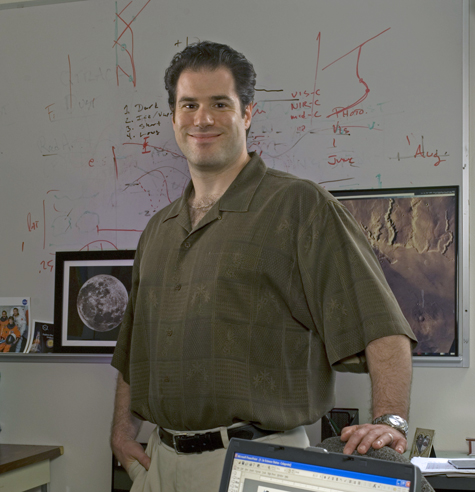LRO First Picture!
Saturday, July 4th, 2009
Two days ago, on July 2, NASA released the first photograph from the new Lunar Reconnaissance Orbiter. And here it is! (Actually, this is just a small piece of it, but a very interesting piece, as I will explain below.)

LRO First Light
The complete photograph is actually a very long strip, something like 500 by 50,000 pixels, taken near the edge of Mare Nubium in the moon’s southern hemisphere. The LRO website ways that the photo was taken near a crater called Hell … I’m not sure why. It doesn’t seem like the best place to start a mission!
If you want to find the location through a telescope or binoculars, it’s at about 30 degrees south latitude and 10 degrees west longitude. To the south is Tycho (one of the brightest craters on the moon), and to the north is an easily spotted trio of craters, Ptolemy, Alphonsus, and Arzachel. The best time for looking at this region was two days ago, when the picture was taken — and that is no accident. Photographers on Earth like to take pictures at sunset or sunrise, and so do lunar photographers! The lunar topography shows up most clearly near the “terminator” — the boundary between the day side and night side of the moon. The LRO spacecraft is currently in a terminator orbit, circling the moon from pole to pole and following the moon shadow around. This is the place to be if you want to take stunning photographs!
There are two very interesting things to notice in this picture. First, at the very bottom, you might notice a string of craters, like beads on a chain. Is this an accident? If not, how is a chain of craters like this formed? The answer is that they are “secondary craters” — craters formed by debris that is blasted off the moon’s surface by a meteorite impact. When the debris lands, it forms smaller craters all in a line. The first person to notice this phenomenon, I believe (perhaps some historians can correct me if I’m wrong) was Ralph Baldwin, an amateur astronomer in the 1940s. At the time, the conventional wisdom was that the moon’s craters were volcanoes. Baldwin put together many pieces of evidence, like this, to conclude that at least some of them were formed by impacts. In this case, the amateur was right and the professionals were wrong.
Also, Baldwin noticed very large-scale linear patterns on the moon, which again seem to radiate outward from some of the great basin impacts. According to the LRO team, you can see some of the linear features in the photograph. I suspect that what they mean is the overall southwest-northeast orientation of the valleys in this photo. These furrows must have been scoured out by a vastly larger and earlier impact than the one that made the little chain of craters that I mentioned above.
As cool as the LRO pictures are, I want to mention that LRO is way, WAY more than just a camera. It has seven extremely cool instruments on it. I will list them below in no particular order of coolness. I will not translate the abbreviations into English — if you want to know what they stand for, check out the LRO website.
- LAMP. How cool is this? We are going to see the dark regions of the moon by starlight. The stars give off ultraviolet light, and the whole darned galaxy glows at one particular wavelength, and we can use this invisible (to human eyes) light to peer into craters that never see the sun.
- Diviner. We’re going to take the moon’s temperature. It’s not the same everywhere. Equatorial regions range from 150 degrees below zero (Celsius) to more than 100 degrees above zero (i.e., hotter than the boiling point of water).If you’re building a lunar base, that’s kind of tough to deal with. But near the poles, the temperature is much more even, although cold — roughly 100 to 120 degrees below zero.
- CRaTER. This one is interesting because it is specifically directed towards human habitation. How much radiation does the moon get from the sun and from outer space? The answer will tell us how long we can keep astronauts on the moon’s surface safely. Remember that the Apollo astronauts were there for only three days or less.
- LEND. Another instrument that will measure radiation — this time neutrons coming from inside the moon. This is kind of a repeat of the experiment that Lunar Prospector did to confirm the presence of hydrogen (and therefore maybe water) at the poles. An interesting point here is that it’s a Russian experiment flying on a NASA spacecraft — a nice example of international collaboration!
- LOLA. This laser altimeter will construct 3-D images of the moon’s surface.
- Mini-RF. A synthetic aperture radar that will search for ice at the lunar poles. This is similar to the Clementine experiment in 1994 that started all the excitement about water at the poles, but I assume it will be much better because it will have a lot more time to gather data and because it was designed for this purpose.
- LROC, the LRO camera, which by now needs no introduction.
I am by no means an expert in all of these technologies (or any of them), but I hope that over the coming months I will have a chance to interview some of the scientists involved with these projects, so that I can tell you how they work.
One thing that I find interesting about the web links is that almost all of them mention that they are “heritage” or “legacy” instruments — in other words, similar experiments have flown on other NASA missions, to Mars or to other planets. In our budget-conscious age, NASA wants equipment that is cheap and reliable. Still, one can’t help feeling a little bit nostalgic for the 1960s and the Apollo missions, when nothing was a legacy experiment — everything was being done for the first time!
